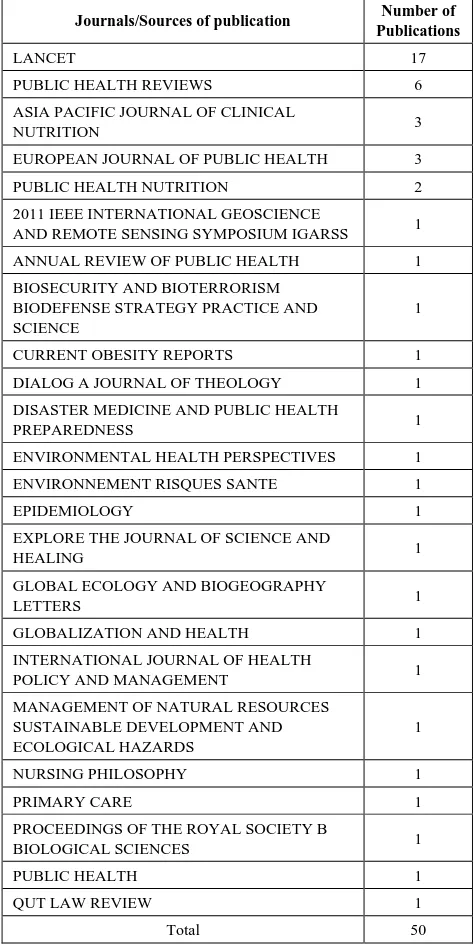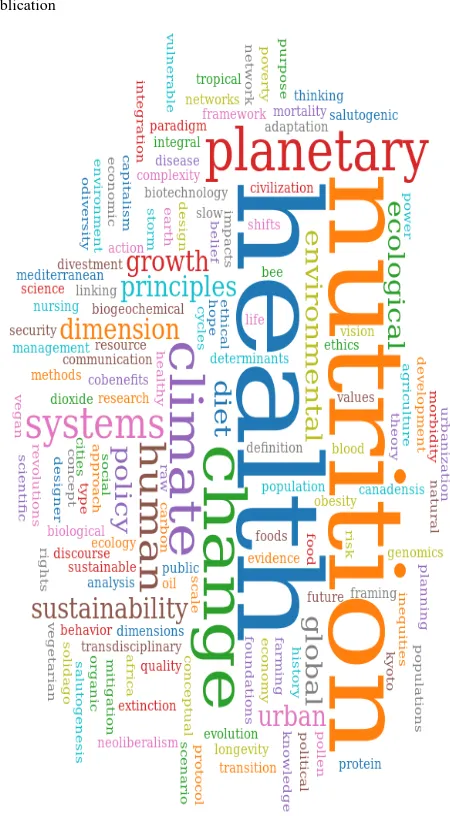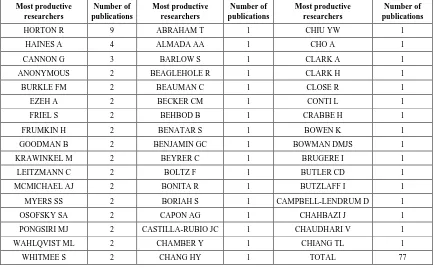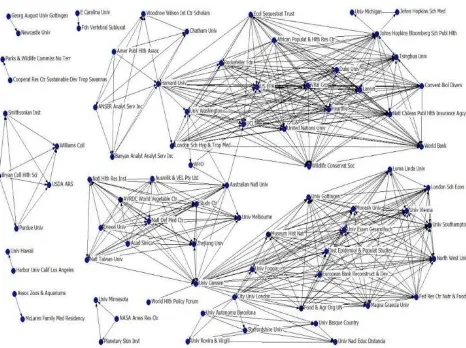Planetary Health: A Scientometrics Analysis of Scientific
Production
Enrique Falceto de Barros1,*, Luciana Calabró2, Ediane Maria Gheno3, Diogo Onofre Souza3
1
MSat Science Education, Universidade Federal do Rio Grande do Sul, Porto Alegre, Brazil 2
PHD Candidate at Science of Health Institute, Federal University of Rio Grande do Sul, Porto Alegre, Brazil 3
Professor at Science of Health Institute, Federal University of Rio Grande do Sul, Porto Alegre, Brazil
Abstract
Planetary Health has been conceived as a new discipline focused on “the health of the human civilization and the health of the natural systems on which it depends”. The overwhelming evidence that we are surpassing the sustainable limits of global ecosystems pushed the World Health Organization of Family Doctors to recommend the introduction of Planetary Health in the core curriculum of medical schools. Despite the growing interest in this concept, its teaching faces many questions, most notably, the query around its sufficiency as an innovative and robust field to be formally introduced in academic health institutions. In order to start this investigation, we performed a scientometric analysis of the indexed articles from 1945 to 2016 about the keyword “Planetary Health” in the Web of Science (WoS) database. Only 50 registries were indexed. The first scientific publication of PH was in 1998, with a marked increase of publications in 2016. We discuss the growing literature on the term, the role of the collaboration between “The Lancet” and Rockefeller Foundation, the incipient networks, and its promising future. We conclude that we need more research and innovative collaboration about this emerging field of Planetary Health in order to establish it in the core disciplines of medicine and science.Keywords
Education, Health, Planetary Health, Scientometrics1. Introduction
Planetary Health (PH) is an emerging multidisciplinary field of knowledge concerned with the interdependencies between the health of our civilization and the health of global ecosystems. PH has been defined as “the health of the human civilization and the natural systems on which it depends” [16]. There is a growing scientific consensus that we have entered the Anthropocene - “a new geological epoch in which humanity [has] become the dominant force shaping our planet’s biophysical conditions” [9], and there is also robust evidence that we are surpassing the sustainable planetary boundaries [13]. This alarming situation has led the World Organization of Family Doctors (WONCA) to publish in 2017 the Statement on Planetary Health and the Sustainable Development Goals recommending the introduction of PH in the core curriculum of medical schools (WONCA, unpublished data), further supported in a joint statement in the 67th session of the European Region of the World Health Organization (WHO, unpublished data).
* Corresponding author:
enriquefbarros@gmail.com (Enrique Falceto de Barros) Published online at http://journal.sapub.org/edu
Copyright©2019The Author(s).PublishedbyScientific&AcademicPublishing This work is licensed under the Creative Commons Attribution International License (CC BY). http://creativecommons.org/licenses/by/4.0/
However, can PH be considered a sufficiently innovative and robust field to be systematically taught in academic health institutions?
innovation offered by PH, it still awaits more convincing demonstration of applicability for the academic medical establishment.
In 2017, we still found relatively few indexed publications explicitly addressing this new field of PH, which enabled us to develop a scientometric panorama as well as a thorough content analysis of the scientific production on Planetary Health. Scientometrics has been used to map scientific trends and gaps, to help guide academic policy and strategy [17] and to (re)set public policies [5]. So we postulate that a scientometric analysis of the published articles about PH up to 2016 would help the understanding of the impact of the scientific community of this field on the health sciences, and also could possibly reveal new pathways for teaching.
2. Materials and Methods
Two methodologies were used to analyze the publications on Planetary Health: 1) Scientometrics [11] and 2) Content Analysis [1].
In the first moment, we made a scientometric study trying to identify the panorama and the characteristics of the indexed scientific production about the keyword “Planetary Health” (types of published documents, number of publications, quality of Journals, most productive researchers, frequency of keywords and collaborations among groups). The data were collected from the database Web of Science (due to its scope and multidisciplinary approach), of Thomson Reuters, in November 17th of 2017, utilizing the access by “Web of Science Core Collection” and the search expression: TS= “Planetary Health”. The data included publications of the Science Citation Index Expanded (SCI-EXPANDED)--1945-present and Social Sciences Citation Index (SSCI)--1956-present. This study covers the period from 1945 to 2016.
All data was imported, treated and normalized in BibExcel [10] and in Microsoft Excel.
The word cloud and the frequency of keywords was generated with the Google add-on Word Cloud Generator, using the keywords from the articles.
The collaboration network (Articles, Reviews and Proceedings papers, totalizing 23 publications) was made using the software UCINET 6, version 6.586. The descriptive analysis corresponds to the 5 institutions with the greatest number of collaborations.
In the second moment, we did a content analysis of these publications. The first author read each article thoroughly and deeply, and searched for general elements that were more common or that differentiated the texts, and observed whether the articles were qualitative or quantitative, conceptual, if they utilized an operational definition of Planetary Health or if they solely cited the newly coined term of PH, and finally if an analytical category of Anthropocentrism emerged. It was beyond the scope of this paper to make a synthesis of all the publications, as it would be too extensive.
3. Results and Discussion
We found 50 registries on the Web of Science about PH. The types of published documents are Editorial Material (18 registries), Articles (16), Proceedings Paper (5), Review (5), Letter (5), Meeting Abstract (3), Biographical Item (1) and Book Chapter (1).
Table 1. Journals/Sources of publications used by the scientific community
Journals/Sources of publication Number of Publications
LANCET 17
PUBLIC HEALTH REVIEWS 6
ASIA PACIFIC JOURNAL OF CLINICAL
NUTRITION 3
EUROPEAN JOURNAL OF PUBLIC HEALTH 3
PUBLIC HEALTH NUTRITION 2
2011 IEEE INTERNATIONAL GEOSCIENCE
AND REMOTE SENSING SYMPOSIUM IGARSS 1
ANNUAL REVIEW OF PUBLIC HEALTH 1
BIOSECURITY AND BIOTERRORISM BIODEFENSE STRATEGY PRACTICE AND SCIENCE
1
CURRENT OBESITY REPORTS 1
DIALOG A JOURNAL OF THEOLOGY 1
DISASTER MEDICINE AND PUBLIC HEALTH
PREPAREDNESS 1
ENVIRONMENTAL HEALTH PERSPECTIVES 1
ENVIRONNEMENT RISQUES SANTE 1
EPIDEMIOLOGY 1
EXPLORE THE JOURNAL OF SCIENCE AND
HEALING 1
GLOBAL ECOLOGY AND BIOGEOGRAPHY
LETTERS 1
GLOBALIZATION AND HEALTH 1
INTERNATIONAL JOURNAL OF HEALTH
POLICY AND MANAGEMENT 1
MANAGEMENT OF NATURAL RESOURCES SUSTAINABLE DEVELOPMENT AND ECOLOGICAL HAZARDS
1
NURSING PHILOSOPHY 1
PRIMARY CARE 1
PROCEEDINGS OF THE ROYAL SOCIETY B
BIOLOGICAL SCIENCES 1
PUBLIC HEALTH 1
QUT LAW REVIEW 1
Total 50
health, ranging from theological issues to nutrition and design (see Table 1).
However, despite discussing and concentrating on global ecological crises, the articles do not carry a unified operational version or definition of “planetary health”.
A marked growth of usage the term PH in the scientific production was observed from 2014, with 9 registered publications (Figure 1) mostly referring to The Lancet Editorial entitled “From public to planetary health: a manifesto” [7], which clearly strives to establish a new paradigm for health stating that “We need a new vision of cooperative and democratic action at all levels of society and a new principle of planetism and wellbeing for every person on this Earth—a principle that asserts that we must conserve, sustain, and make resilient the planetary and human systems on which health depends by giving priority to the wellbeing of all.” In 2016 we observe a doubling of the number of publications (18), mostly dialoguing to The Lancet-Rockefeller project for a new discipline of planetary health [6]. Despite the very heterogeneous approaches and methodologies in the corpus of registries referring to PH, ranging from design, religion, international relations, to remote sensing, etc, they mostly make a complementary and coherent body of knowledge and a growing platform for a new discipline.
Figure 1. Growth of the scientific publication about Planetary Health
The publications up to 2016 had a total of 361 citations, obtaining an average of 7,22 citations per document.
The countries with the greater number of publications are visualized in Figure 2, lead by the United States.
Figure 2. Number of publications per country. Note that colors go from light yellow to red as the number of publications increases
Figure 3. Categories of the Web of Science journals/sources of publication
Figure 4. Word cloud of keywords from publications
Journal comes from a rare and highly propositional editorial line and vision, in partnership with the Rockefeller Foundation, clearly aiming to redirect scientific research to a more planetary perspective [12].
The majority of the journals studied are inserted in the categories of Public Environmental Occupational Health (19), Medicine General Internal (18), Nutrition Dietetics (5) e Environmental Sciences (2) (see Figure 3), however the scope of journals involves such heterogeneous disciplines as law (1 article), remote sensing (1 article), international relations (1 article) and religion (1 article), which indicates the multidisciplinary nature of PH.
Table 2. Top 10 most frequent keywords from publications
Word Frequency
Health 28
Nutrition 26
Change 13
Planetary 10
Climate 9
Human 6
Systems 6
Global 5
Environmental 4
Principles 4
A picture “word cloud of keywords” (Figure 4) highlights the main topics from the articles, and Table 2 shows the total number of the top 10 keywords. It should be noted that only 24 articles (of the total 50 registries) provided keywords, and that the 2 articles from the Public Health Nutrition Journal
mentioned the Keyword Nutrition 22 times, so the picture may be skewed towards the theme nutrition. Nonetheless, such picture helps visualize the great heterogeneity and complexity of the articles studied.
Table 3 Shows the most productive authors are Horton R (9), Haines A (4) and Cannon G (3). Horton R wrote 8 Editorial Material and 1 Review. Haines A wrote 2 Editorial Material, 1 Review and 1 Article. Cannon G published 3 Article/ Proceedings Paper.
Aiming to analyze the networks of collaboration among institutions, we restricted our scope to Articles, Proceedings Papers e Reviews, which accounted to 23 publications. The institutions that established a greater number of collaborations were: Geissen, Germany (28 links), Harvard Univ. United States (23), Univ. Washington United States (21), City Univ London (United Kingdom 21) and UCL (United Kingdom 20), Figure 5.
From the total of 50 registries analyzed, we observed only two articles predominantly using quantitative methods, while the remaining registries were predominantly qualitative and/or conceptual. This finding alone would deserve a more careful and complex analysis, however, for now it may suffice to note it seems related to the initial development of a new scientific concept, when clear definitions and quantitative applicability are still lagging behind more philosophically open inquiries. It is very interesting to note that of all articles only 5 were not anthropocentric, while all the other papers - notably after the leadership of The Lancet publications - argued about PH as an instrumental framework to achieve better human health, reinforcing a previous analysis that PH is indeed anthropocentric [8]. Table 3. Most productive researchers on the theme. There are 77 authors for the 50 publications, with an average of 1,54 authors per article
Most productive researchers
Number of publications
Most productive researchers
Number of publications
Most productive researchers
Number of publications
HORTON R 9 ABRAHAM T 1 CHIU YW 1
HAINES A 4 ALMADA AA 1 CHO A 1
CANNON G 3 BARLOW S 1 CLARK A 1
ANONYMOUS 2 BEAGLEHOLE R 1 CLARK H 1
BURKLE FM 2 BEAUMAN C 1 CLOSE R 1
EZEH A 2 BECKER CM 1 CONTI L 1
FRIEL S 2 BEHBOD B 1 CRABBE H 1
FRUMKIN H 2 BENATAR S 1 BOWEN K 1
GOODMAN B 2 BENJAMIN GC 1 BOWMAN DMJS 1
KRAWINKEL M 2 BEYRER C 1 BRUGERE I 1
LEITZMANN C 2 BOLTZ F 1 BUTLER CD 1
MCMICHAEL AJ 2 BONITA R 1 BUTZLAFF I 1
MYERS SS 2 BORIAH S 1 CAMPBELL-LENDRUM D 1
OSOFSKY SA 2 CAPON AG 1 CHAHBAZI J 1
PONGSIRI MJ 2 CASTILLA-RUBIO JC 1 CHAUDHARI V 1
WAHLQVIST ML 2 CHAMBER Y 1 CHIANG TL 1
Figure 5. Network of collaboration among the institutions
Our study points PH as a multidisciplinary field of research opening an academic niche still relatively unexplored, which tries to focus on the interconnections among heterogeneous areas of knowledge. The identification of the Anthropocene and of the planetary boundaries does appear to call for urgent innovative scientific and technological approaches. This may illustrate what Fortunato called as “conservative strategies may be less effective for science as a whole” [3]. The same author sees interdisciplinary research as “an emblematic recombinant process, and when it achieves a successful combination of previously disconnected ideas and resources that is fundamental to interdisciplinary research, it often violates expectations and leads to novel ideas with high impact” [3]. So, here we ask once more: Could PH be a successful example of a promising burst in scientific publications corresponding to the emergence of a new influential paradigm in science? Here the anonymous anecdote of “the researcher that arrives home at night and drops his house keys in the bushes just in front of the door, and stubbornly only looks for it in the lighted steps, avoiding the challenges of putting his hand in the uncertainties of the shady shrubs” - may illustrate the sometimes insufficient incentives to academics for entering a new knowledge frontier, to step out of the comfort zone and to take the less traveled and riskier roads. Therefore, we see with interest the groundbreaking initiatives like that of the prestigious The Lancet and of the Rockefeller Foundation to take the lead in this dawning collaboration for PH.
It is still early to say whether the novelty of PH may become established within the health sciences, and fulfill its promise of “the highest attainable standard of health, wellbeing, and equity worldwide through judicious attention to the human systems—political, economic, and social—that shape the future of humanity and the Earth's natural systems that define the safe environmental limits within which humanity can flourish” [16]. However, we should not be afraid to say that the health and natural sciences would probably benefit “if curiosity, creativity, and intellectual exchange—particularly regarding the societal implications
and applications of science and technology [concerning the planetary boundaries] — are better appreciated and incentivized in the future” [3]. In other words, we need to face the imposing “imagination challenge” clearly described by Whitmee et al [15]. We need to imagine that science can and should serve a greater good, and PH does offer a promising platform for such an endeavor. Low-middle income countries (LMIC) like Brazil may have much to offer to this new scientific field, and may especially benefit from the core concept of equity, as proposed by Planetary Health.
Our scientometric approach on scientific publications concerning Planetary Health may indicate that the scientific community involved in publishing about PH is incipient, still learning about this topic and just beginning to create the necessary innovative methodological bridges that could lead to the more robust multidisciplinary and multinational collaborations envisioned to safeguard human health in the anthropocene epoch.
Finally, despite our understanding that PH is a promising concept for the health sciences, our study found few indexed publications about it up to 2016, and furthermore, we did not find any indexed articles specifically addressing the introduction of PH in health sciences education. We should note that in 2018 The Lancet Planetary Health Journal became indexed in Pubmed, which may strongly contribute to the development of this field. We conclude that we need more research and collaboration on this emerging field of PH, especially in education, in order to establish it in the core curriculum of the undergraduate courses in health sciences.
REFERENCES
[1] L. Bardin. Análise de Conteúdo. Lisboa, Portugal, Edições 70, LDA, 2009.
[2] D. M. J. S. Bowman Death of biodiversity - the urgent need for global ecology. Global Ecology and Biogeography Letters, vol. 7 (4), pp.237-240, Jul. 1998.
[3] S. Fortunato, C. T. Bergsrom, K. Borner, A. Evans, D.Helbing, S. Milojevic et al. Science of science. Science, vol. 359 (6379), pp. Eaao0185, Mar. 2018.
[4] J. Frenk, L. Chen, Z. A. Bhutta, J. Cohen, N. Crisp, T. Evans, H. Fineberg et al. Health professionals for a new century: transforming education to strengthen health systems in an interdependent world. Lancet, volume 376 (9756), pp.1923-1958, Dec. 2010.
[5] E. M. Gheno, D. B. Rosemberg, D. O. Souza and L. Calabro. “Zebrafish in Brazilian Science: Scientific Production, Impact, and Collaboration.” Zebrafish, volume 13 (3), pp. 217-225, Jun. 2016.
[6] R. Horton and L. Selina. “Planetary health: a new science for exceptional action”. Lancet, vol. 386 (10007), pp. 1921–1922, Nov. 2015.
Lancet, vol. 383 (9920), pp. 847, Mar. 2014.
[8] H. Lerner and C. Berg. “A Comparison of Three Holistic Approaches to Health: One Health, EcoHealth, and Planetary Health”. Frontiers in Veterinary Scienc, volume 4, pp. 163, 2017.
[9] S. S. Myers. “Planetary health: protecting human health on a rapidly changing planet”. Lancet, vol. 390 (10114), pp. 2860-2868, Dec. 2017.
[10] O. Persson, R. Danell, J. Schneider. “How to use Bibexcel for various types of bibliometric analysis”. In: F. Åström, R. Danell, B. Larsen, J. Scheneider (Ed.) Celebrating scholarly communication studies: A Festschrift for Olle Persson at his 60th Birthday, pp. 9–24, Leuven, Belgium: International Society for Scientometrics and Informetrics, 2009.
[11] D. J. S. Price. Little Science, Big Science... and Beyond. New York: Columbia University Press, 1986.
[12] D. Rockefeller. The role of foundations: Rockefeller Foundation. Public Health Reviews, vol. 37 (32), 2016. [13] W. Steffen, K. Richardson, J. Rockström, S. E. Cornell, I.
Fetzer, E. M. Bennett, at al. Planetary boundaries: Guiding human development on a changing planet. Science, vol. 347 (6223), 1259855, Feb. 2015.
[14] G. Tett. The Silo Effect: Why Putting Everything in Its Place Isn’t Such a Bright Idea. London: Little, Brown, 2015. [15] V. Wass and L. Southgate. Doctors Without Borders.
Academic Medicine, vol. 92 (4), pp. 441–443, 2017.
[16] S. Whitmee, A. Haines, C. Beyrer, F. Boltz, A.G. Capon, B. F. S. Dias, et al. Safeguarding human health in the Anthropocene epoch: report of The Rockefeller Foundation - Lancet Commission on planetary health. Lancet vol. 386 (10007), pp. 1973-2028, Jul. 2015.
[17] J. Wojciechowski, F. Ceschin, S.C.A.S. Pereto, L. G. S. Ribas, L. A. V. Bezerra, J. Dittrich, T. Siqueira et al. Latin American scientific contribution to ecology. Anais da Academia Brasileira de Ciências, vol. 89 (4), pp. 2663-2674, Oct. 2017. [18] E. XIE, E. F. BARROS, A. ABELSOHN, A. T. STEIN and A.



